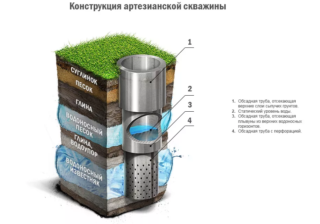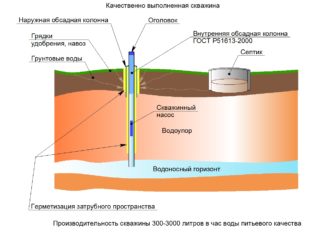Artesian wells have many advantages, but the arrangement itself is expensive. To make or not to make a well on limestone is a matter of finance, but subsequently there will be less problems with exploitation than with cheap Abyssinian and sand sources.
Artesian well and its varieties
 To understand what an artesian well is, you need to know how the layers lie in the ground and where the water is between them. Above all, there are sources that are called overheads. These are small deposits on a waterproof layer of clay or stone. For domestic needs, you can drill a shallow well and water the garden in the summer. The most unpleasant thing is that in summer the amount of liquid in such sources is small - they are fed in the spring after snow melt and in the fall after precipitation. A large amount of chemicals enters the upper waters, so drinking it is not recommended before laboratory tests.
To understand what an artesian well is, you need to know how the layers lie in the ground and where the water is between them. Above all, there are sources that are called overheads. These are small deposits on a waterproof layer of clay or stone. For domestic needs, you can drill a shallow well and water the garden in the summer. The most unpleasant thing is that in summer the amount of liquid in such sources is small - they are fed in the spring after snow melt and in the fall after precipitation. A large amount of chemicals enters the upper waters, so drinking it is not recommended before laboratory tests.
Next are groundwater. They lie on a waterproof layer of clay, on which there is an aquifer of sand. The liquid is absorbed over the entire area of the water vein, may contain residual effluents from septic tanks or livestock farms. To use the well constantly, you need to ensure the purity of the source. In wells in the sand, the fluid level changes depending on the time of year, but mostly there is water all year round.
The interstratal water veins are protected by a water-resistant layer located on top, so the liquid in them is cleaner than in the sand layer. In some places, they can combine, so the water is first checked for chemicals and organics. If there is a clean well in the area, there is no need to drill deeper.
Artesian wells provide the cleanest water of all existing in nature. The source of recharge is usually very far away - for tens and hundreds of kilometers from the place of water intake. It can be a full-flowing river or the sea. The fluid circulates in the layers of limestone, gypsum or marl. May be pressure or non-pressure. The second are very rare. Artesian pools are multi-level vertically located aquifers that occupy vast areas.
The depth of an artesian well can be up to 300 meters. Despite this, the fluid level is always higher than the level of the aquifer, as pressure pushes it closer to the surface. In mountainous regions, the artesian layer may be shallow, which facilitates the drilling process.
Advantages and disadvantages of limestone wells
 In addition to the purity and transparency of artesian water, limestone wells have the following advantages:
In addition to the purity and transparency of artesian water, limestone wells have the following advantages:
- inexhaustible supply of water at any time of the year;
- the absence of seasonal fluctuations in the liquid level, which is a safe moment when operating submersible equipment;
- maintenance is not required unlike sand wells that need to be cleaned every 5 years;
- a service life of more than 50 years, subject to proper installation and use of high-quality materials for the casing;
- quick self-sufficiency of the source, if the water has useful qualities, but then it will be necessary to drill over 400 m in depth.
There are also disadvantages. Each region has its own chemical composition of the liquid, since the layers may contain various substances whose ions fall into the water. It may be necessary to install additional filters to reduce the amount of iron or magnesium. Magnesium gives a bitter aftertaste, and iron after precipitation in the air precipitates and also has a not very pleasant taste of rusty nails.Exceeding the norm of calcium makes the liquid stiff. It is problematic to wash hair with such water, and it negatively affects the condition of the skin.
Prices for drilling artesian wells for water are quite high. Given the depth, the source together with a set of pumping equipment can cost about 100 thousand rubles or more. It is almost impossible to drill an artesian well on your own, therefore, they turn to specialized companies for help.
To get permits for the arrangement of wells on limestone, you need to spend time. Such a document is not required during the construction of a conventional needle-well.
Drilling technology
 If you decide to drill an artesian well, you need to responsibly approach the choice of company, materials for the casing of the mine and the structure of the well itself. Firms, attracting customers, offer low prices for services and materials, as a result, an artesian well can quickly become worthless.
If you decide to drill an artesian well, you need to responsibly approach the choice of company, materials for the casing of the mine and the structure of the well itself. Firms, attracting customers, offer low prices for services and materials, as a result, an artesian well can quickly become worthless.
An important rule is that plastic pipes cannot be used at a depth below 25 meters - they are deformed when the soil layers are shifted and dirt gets into the water. Metal casing is also not an option, since rust quickly forms on the walls, which passes into the water.
Companies that value their reputation do not offer to save money and make an external pipe from metal, but an internal one from plastic. It will cost more, but the design will be reliable. Changing the pipe at a depth of over 100 - 200 meters is very problematic - you have to get the whole casing, and this is the cost of another well.
 The stages of work are the destruction of hard rocks, the extraction of soil and the installation of pipes of different diameters. Since it is not known in advance at what depth it will be necessary to drill, a large chisel is used and the shaft is made wider in order to be able to lower the pipes one into another in a telescopic way for casing.
The stages of work are the destruction of hard rocks, the extraction of soil and the installation of pipes of different diameters. Since it is not known in advance at what depth it will be necessary to drill, a large chisel is used and the shaft is made wider in order to be able to lower the pipes one into another in a telescopic way for casing.
Drilling is carried out by several methods:
- direct rinsing rotor;
- blowing;
- backwash;
- shock way.
90% of all artesian wells are rotary with direct washing with clay mud. The drilling rig is selected depending on the estimated drilling depth, the width of the shaft diameter.
An important point: to protect clean artesian water from groundwater, insulation is used. Usually use expensive clay, which swells in a humid environment and prevents the mixing of aquifers - compactonite. Before concluding the contract, you need to find out what type of insulation the company works with, since the material can be cheap and will not perform its functions.
After installing the casing and insulation, the pipes are washed with clean water and samples are taken for analysis. Further, the well is put into operation along with a technical passport.
Terms of Use
After completion of construction work, it is necessary to install a submersible pump or pump station if the distance to the water mirror does not exceed 8 meters. Over the next 3 to 4 months, you should observe how the fluid level in the well changes so as not to damage the pumping equipment. If the level does not change, then there is no need to lower the intake hose or submersible pump.
The upper part must be hermetically sealed so that dirt or organic matter that can cause bacterial contamination of the water does not get into the pipe.
Design options

To obtain permission for construction work, you must apply for:
- drilling license;
- license for the well itself.
If you contact the company officially, they themselves prepare documents and register the source. With self-registration, delays are possible.
First of all, a statement is written to the Ministry of Natural Resources, after which a commission is created that decides whether it is possible to equip the well in a selected place. Further, the owner of the site collects documents, obtains permission from Rospotrebnadzor and approves the well project in Regional Commodity. All papers are transferred to the Department of Subsoil Use, after which a license is issued, which gives the right to contact companies that are officially engaged in drilling and are licensed.
After completion of construction work, an examination of the design and analysis of water is carried out, a conclusion of the relevant authorities is written. The source is entered in the cadastral register. It is important that by the time of commissioning the first zone of the sanitary zone be equipped.
In order to obtain a license for a well to an individual, it is necessary to pay a fee in the amount of 500 thousand to 1.5 million rubles. For legal entities this will cost 2 times more expensive. The term of the document is up to 1 year.


